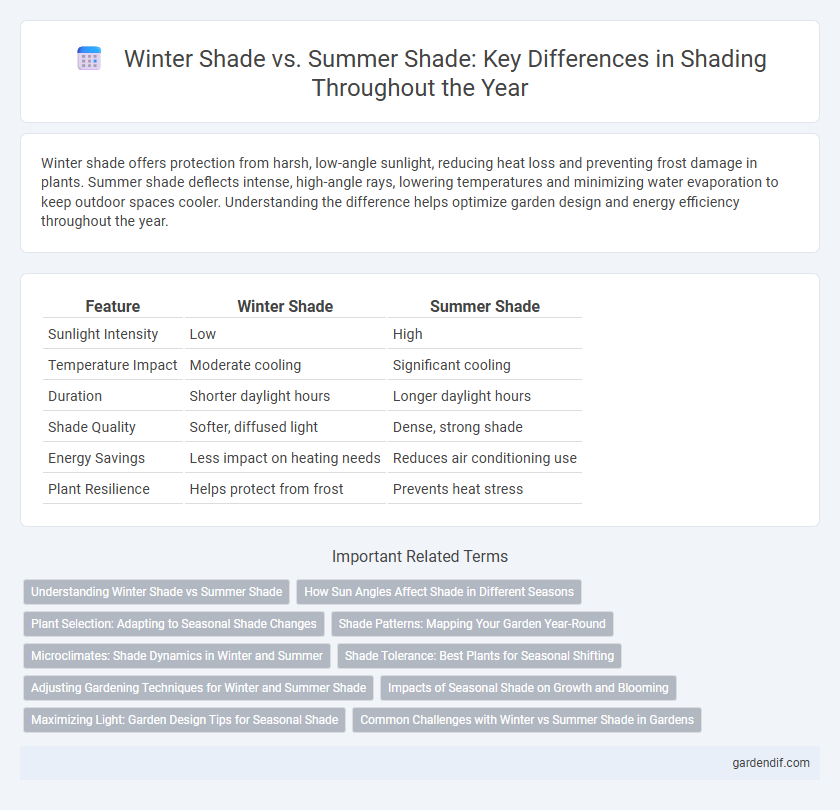
Winter shade vs summer shade Illustration
Winter shade offers protection from harsh, low-angle sunlight, reducing heat loss and preventing frost damage in plants. Summer shade deflects intense, high-angle rays, lowering temperatures and minimizing water evaporation to keep outdoor spaces cooler. Understanding the difference helps optimize garden design and energy efficiency throughout the year.
Table of Comparison
| Feature | Winter Shade | Summer Shade |
|---|---|---|
| Sunlight Intensity | Low | High |
| Temperature Impact | Moderate cooling | Significant cooling |
| Duration | Shorter daylight hours | Longer daylight hours |
| Shade Quality | Softer, diffused light | Dense, strong shade |
| Energy Savings | Less impact on heating needs | Reduces air conditioning use |
| Plant Resilience | Helps protect from frost | Prevents heat stress |
Understanding Winter Shade vs Summer Shade
Winter shade occurs when the sun is lower in the sky, casting longer shadows that provide cooler, diffused light ideal for plants with low light requirements. Summer shade results from the sun's higher position, creating shorter, more intense shadows that filter strong sunlight to protect heat-sensitive species. Recognizing the differences in light intensity and duration between winter and summer shade supports optimal plant growth and landscape planning.
How Sun Angles Affect Shade in Different Seasons
Winter shade tends to be longer and cast at a lower angle because the sun remains low in the sky, resulting in extended shadow coverage throughout the day. Summer shade is shorter and more directly beneath objects due to the sun's higher position, creating compact and intense shadow areas. These variations in sun angles significantly influence the availability and quality of shade, impacting temperature regulation and plant growth in different seasons.
Plant Selection: Adapting to Seasonal Shade Changes
Winter shade typically offers more indirect sunlight due to the lower sun angle, making it suitable for plants like hellebores and camellias that thrive in cooler, low-light conditions. In contrast, summer shade often involves dappled or dense shade created by fully leafed trees, favoring shade-tolerant plants such as hostas and ferns that can handle intermittent sunlight and higher temperatures. Selecting plants adapted to these seasonal light variations ensures healthy growth and maintains garden vitality year-round.
Shade Patterns: Mapping Your Garden Year-Round
Winter shade often results from low-angle sunlight casting long shadows from trees and structures, creating cooler, consistently shaded areas ideal for shade-tolerant plants. Summer shade typically comes from overhead foliage blocking intense midday sun, producing dappled or partial shade patterns crucial for heat-sensitive species. Mapping these seasonal shade variations enables gardeners to strategically position plants according to their light requirements throughout the year.
Microclimates: Shade Dynamics in Winter and Summer
Winter shade often results in colder microclimates with reduced sunlight exposure, leading to lower soil temperatures and slower plant growth. Summer shade, by contrast, creates cooler microclimates by blocking intense sunlight, which helps reduce heat stress and water evaporation in plants. Understanding these seasonal shade dynamics is crucial for optimizing garden plant selection and landscape design to support healthy microclimates year-round.
Shade Tolerance: Best Plants for Seasonal Shifting
Winter shade typically results in lower light intensity and cooler temperatures, favoring shade-tolerant plants like hellebores, ferns, and winterberry that thrive in these conditions. Summer shade, often characterized by dappled or partial shade, supports plants such as hostas, astilbes, and impatiens, which require moderate light and warmer temperatures to flourish. Selecting plants based on their shade tolerance for specific seasonal light variations ensures healthy growth and vibrant garden displays throughout the year.
Adjusting Gardening Techniques for Winter and Summer Shade
Winter shade requires gardeners to select shade-tolerant plants that thrive in low light and cooler temperatures, such as hellebores and ferns, while ensuring proper soil moisture to prevent drying out. Summer shade demands attention to heat-sensitive plants, using mulches to retain soil moisture and implementing strategic pruning to maximize airflow and reduce heat stress. Adjusting watering schedules and choosing season-specific fertilizers enhance plant health in both winter and summer shaded garden areas.
Impacts of Seasonal Shade on Growth and Blooming
Winter shade reduces light availability significantly, slowing photosynthesis and potentially stunting growth in deciduous plants. Summer shade, often caused by dense canopy cover, can lower leaf temperature and reduce water stress, promoting healthier foliage but sometimes limiting flowering in sun-loving species. Understanding these seasonal shade impacts helps optimize plant selection and garden design for robust growth and vibrant blooms year-round.
Maximizing Light: Garden Design Tips for Seasonal Shade
Winter shade tends to be less dense as trees lose their leaves, allowing more sunlight to penetrate and benefit shade-tolerant plants during colder months. Summer shade is often denser due to full foliage, requiring garden designs that incorporate light-loving understory plants or reflective surfaces to maximize available light. Effective garden planning balances seasonal light fluctuations by selecting species and positioning elements that optimize natural light exposure throughout the year.
Common Challenges with Winter vs Summer Shade in Gardens
Winter shade in gardens often results in reduced light intensity, limiting photosynthesis and slowing plant growth, whereas summer shade can lead to overheating and moisture stress despite cooler conditions. Common challenges with winter shade include limited daylight hours and persistent low temperatures that hinder seed germination and root development. Summer shade, while protecting plants from intense sun, may also trap humidity and foster fungal diseases, requiring careful management of airflow and soil drainage.
Winter shade vs summer shade Infographic

 gardendif.com
gardendif.com